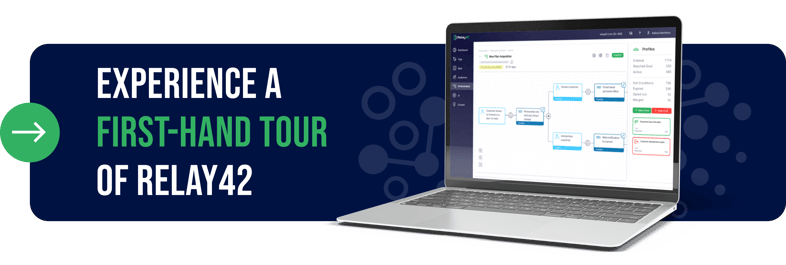A Practical Guide to Omnichannel Marketing for Telecoms
by Relay42 on 27.1.2021

Table of contents
- The need to resolve the customer identity crisis
- Time to get on board with the omnichannel customer journey
- Challenges: Telecom providers struggle to connect online and offline channels
- Objectives
- Phase 1: Recognizing the crowd
- Architectural landscape
- Phase 2: Acquisition
- Phase 3: Retention
- Future projections
The need to resolve the customer identity crisis
Today’s customers don’t make distinctions between web browsing, search results, mobile or desktop, or specific social media platforms. They hunt down what they want, when they want it, for the lowest price available. And they expect a consistent, personalized experience every time they interact with a brand.
This has been the status quo for years, yet the strategies, business models, and organizational alignments found in today’s businesses seem stuck — either unwilling or unable to adapt.
Instead, customers are fed untimely, annoying, and often irrelevant messages — like a contract upgrade a year before it is due — which only serves to drive them away as they wrestle back control over the buying process.
Did you know...
- 83% of consumers say the ability to move from one assisted channel to another, such as moving from web chat to a live conversation, is desirable (Genesys).
- 63% of U.S. consumers say they'd share more personal information with a company that offers a great experience (PWC).
- 31% of respondents rated being able to contact the company through any channel as the top driver of feeling emotionally connected to a brand (New Voice Media).
Mining owned data to deepen customer understanding
As the internet of things (IoT) grows ever-more connected, capturing and utilizing the valuable information shared by consumers will prove instrumental in transforming your current challenges into opportunities, such as those detailed in this eBook.
Time to get on board with the omnichannel customer journey

When it comes to escalating marketing activities, connecting devices and channels will help marketers stay on track and avoid further delays.
Start by connecting the closest platforms to your business first, and keep up with your customers as they branch out into new areas. This will allow you to create a solid network of continuity, insights, and interactions.
Challenges: Telecom providers struggle to connect online and offline channels
After highlighting some common telecom challenges below, we'll go on to give you a proven, step-by-step methodology for telecom providers to keep up with an ever-developing customer pathway through smart marketing choices, connection, and automation.
Omnichannel strategy
With an outcrop of digital channels growing at an increasing rate, consumer access points become impossible to manage, along with the dialogue between digital and offline content. This lack of channel connectivity means that telecom companies are unable to prevent consumers from receiving different — and often irrelevant — messages via several channels.
Consistent messaging across online and offline channels
Many marketing departments end up in a situation where they're optimizing each channel individually using A/B split testing, which leads to inconsistent messaging across web, display, social, and email.
Even if an organization has a wealth of information per channel about their customers and prospects, the inability to relate this to online marketing efforts leads to scattered mass media buying.
Scalable marketing automation solution
A lack of synchronization becomes more and more of a pressing issue. With fewer new customers entering the sector, upsell and retention become more crucial. Without the capabilities mentioned above, no company can expect to scale its marketing operations to meet today's cross-channel demands.

Objectives
Phase 1: Recognizing the crowd
• Identify visitors: Identify new customers and existing customers to deliver messages accordingly.
• Create a single customer view: This is achieved by connecting existing architecture to the Relay42 platform.
Phase 2: Acquisition
• Earn new customers by serving personalized targeted messages on both owned media and external sites.
• Implement experimental marketing techniques more accurately by using the existing customer recognition framework.
Phase 3: Retention
• Improve retention and decrease churn through better service, and personalized deals.
• Increase upsell and cross-sell – in terms of packages and across channels – on both owned media and external sites.
• Reduce annoyance of existing customers caused by irrelevant ads.

Phase 1: Recognizing the crowd
After establishing which departmental integrations were most appropriate, this leading telecom company identified the need for an agnostic solution to connect their disparate channels and action their data accurately and efficiently.
They would also need an agency to assist with conceptualization, planning, and division of labor.
Creating a multi-disciplinary team
Choosing a project team with the right strengths and skill-sets will become the foundation of your customer-centric marketing strategy. Consider the creative input and specialism required in this management process: tailor-making pathways for your customers will require a closely aligned team with the right acumen in order to see it through – from banner design to conversion expertise.
The multi-disciplinary task force
- Project manager
- Project lead
- Web specialist
- CRM specialist
- Online channel manager
- Online conversion specialist
- Data Management consultant
5 steps to connecting your framework
The company began using the Relay42 platform to connect internal and external data sources to form a panoramic view of each individual customer. They were then able to analyze and activate their data in real time via single user profiles by following these steps:
1. Connect the CRM with all online channels including web, social, search, and display.
2. Combine CRM data with useful information gathered from the moment a user begins interacting with owned and external online channels.
3. Create rules in the platform to offer the most effective messaging per user, per touchpoint, by combining behavior data from your website with information from email campaigns, usage of search engines, social media activities, time slots for TV ads, and interactions with affiliate channels and other paid media.
4. Collect additional identifying elements to augment the visitor’s profile with information from the CRM, including current product ownership,next-best-offers, and eligibility for specific packages.
5. Enable actions to be created in real time so you can scale this setup to keep pace with multiple channels, and serve customers the right content at the right time.
Architectural landscape
Below is an example of what your architectural framework could look like based on the channels you would like to integrate.
Notice that all customer touchpoints and relevant business systems are in dialogue with one another in real time.

Phase 2: Acquisition
Now the telecom company has laid the foundation for producing statistics that are actionable in real time, which means they now have the ability to automate omnichannel messaging. Everything is in place, so it’s time to zoom in on big data and create small data in order to make smart decisions at the right moment:
• Specific offers and messaging linked to variables like geo-information and online behavioral patterns are designed to convert prospects and win their loyalty.
• Abandoned shopping cart reminders are triggered for those who have not completed orders within a given time frame.
• Showing broadband and streaming service offers via email content and display based on a user occupying a specific WiFi spot or streaming specific movies on a connected cloud (via CRM data and previous purchase history) to highlight local capabilities, products, and relevant offers.
• Emailing fiber broadband packages to users who apply, based on collecting data on their home infrastructure viability for the product (acquired through web geo-location).
• Fitting SEA content with current ISP based on customer meta-data from partnering websites means the telecom company can distribute personalized ads, for example customizing an internet speed test page based on the speed of the visitor's ISP.
• Experimental tweaking and testing to refine all of the points above based on learnings allows you to create carefully selected focus groups based on behavior so as not to split-test, but rather to make small incremental changes to your messaging and actions.
Read how Mazda increased leads and doubled their effectiveness with the Relay42 platform.
Phase 3: Retention
Now that you’ve made eye contact with your prospects, it’s time to build a solid relationship with existing customers, in order to fully utilize every retention and upsell opportunity:
Existing customer actions
• Omnichannel messaging and continuity: It’s a simple and beneficial by-product of connecting your various marketing channels. Continuity in messaging and user experience across channels means users are less likely to stray.
• Produce fitting win-back content on owned channels: Based on partner site behavior, like that of price comparison websites, a telecom company can identify when their customer’s contract is nearing its end (via CRM) and tailor the content on their various owned channels to fit the reconsideration phase; for example via a win-back campaign.
• Upsell and cross-sell effectively: Use CRM product purchase history to email customized offers. Using CRM purchase history and both real-time and historical data allows your organization to offer optimal packages and deals to loyal customers. This helps you get it right with granular precision and reduce your churn rate.
• Reduce customer annoyance and unite social and CRM to provide a first contact solution: By fusing Facebook and email you can maximize on real-time data management to offer a broader context and ensure customer issues are addressed, and rectified, immediately.

Read how Vattenfall retained customers and gained an 888% ROAS.
Future projections
Who in your company “owns” the customer? This telecom example teaches us that customer care is no longer a departmental fragment within a business, but a unified way of thinking – just as the devices consumers use and the touchpoints they move through should be unified in their messages and offerings.
Now that they have their omnichannel foundation in place, this industry leader is making way for bigger organizational strides. Currently, they're creating connections between web and call center – a development that will make way for personalized on-screen banners, optimized in real-time depending on a user’s call history, and cementing the research-online-purchase-offline route customers so frequently choose.
Technology to help provide VIP service
Accumulating vast quantities of data is not the real crux of the challenge going forward. What companies must really focus on is balancing quantity and quality by using audience intelligence and targeting to elevate both new and existing customers to the VIP status they seek.
Business sectors from travel to retail are setting the standard for boutique services, tailor-built to answer to the needs of the individual rather than broadcasting to the masses.
From mobile and broadband operators to TV providers, many telecom companies have become jacks-of-all-trades, incorporating all of these offerings into their customer packages.
Going forward, the challenge will be to become the master of one.
You May Also Like
These Related Stories

How to Revolutionize Your Marketing Approach with Data

Making Responsible Marketing Your Differentiator



